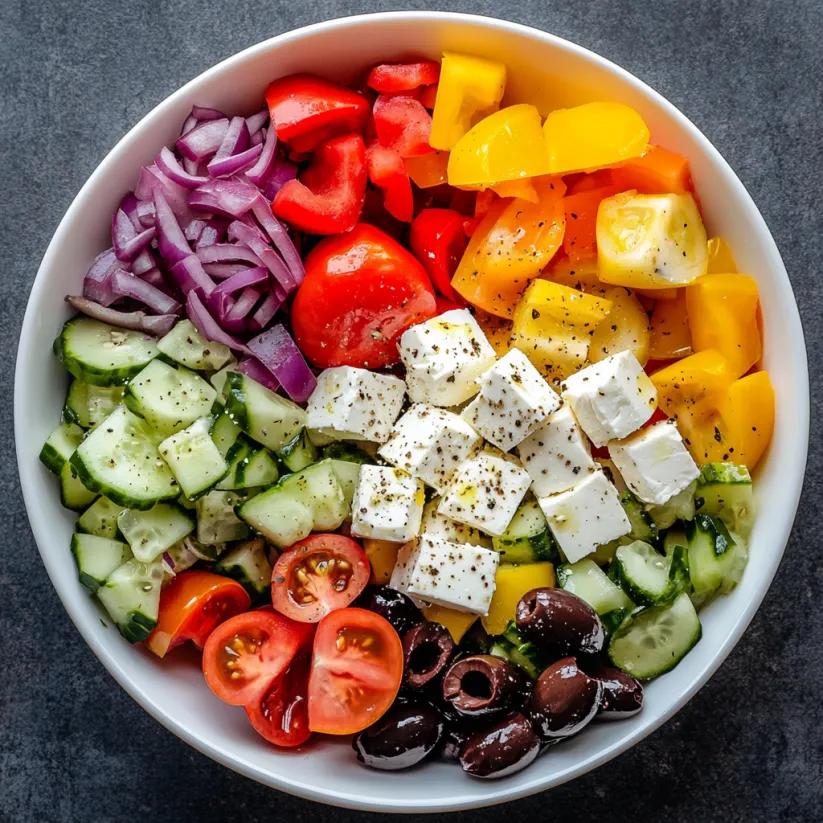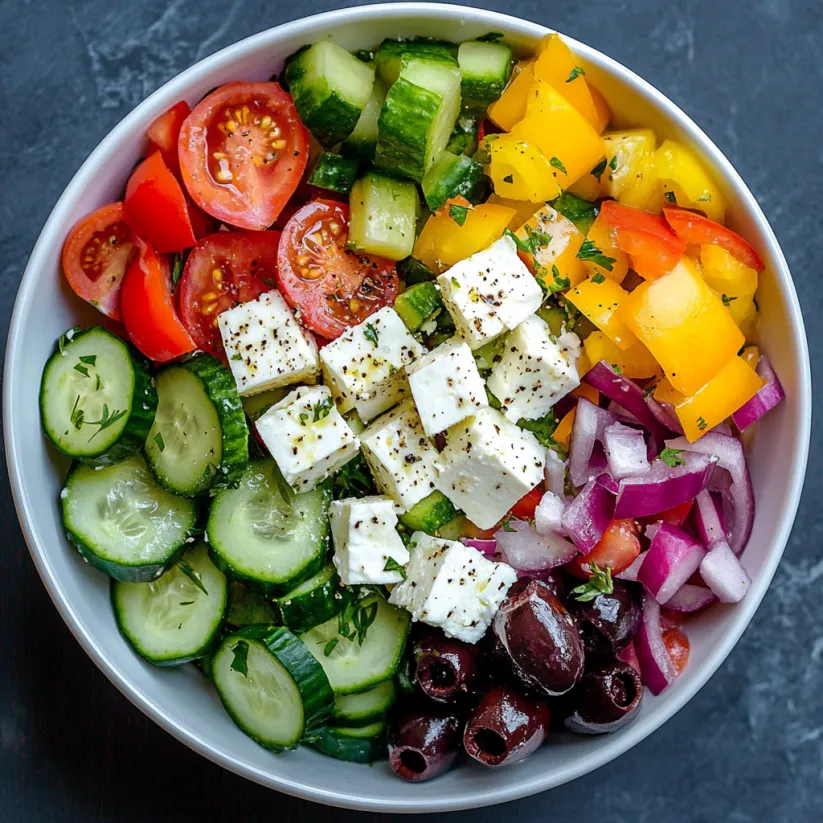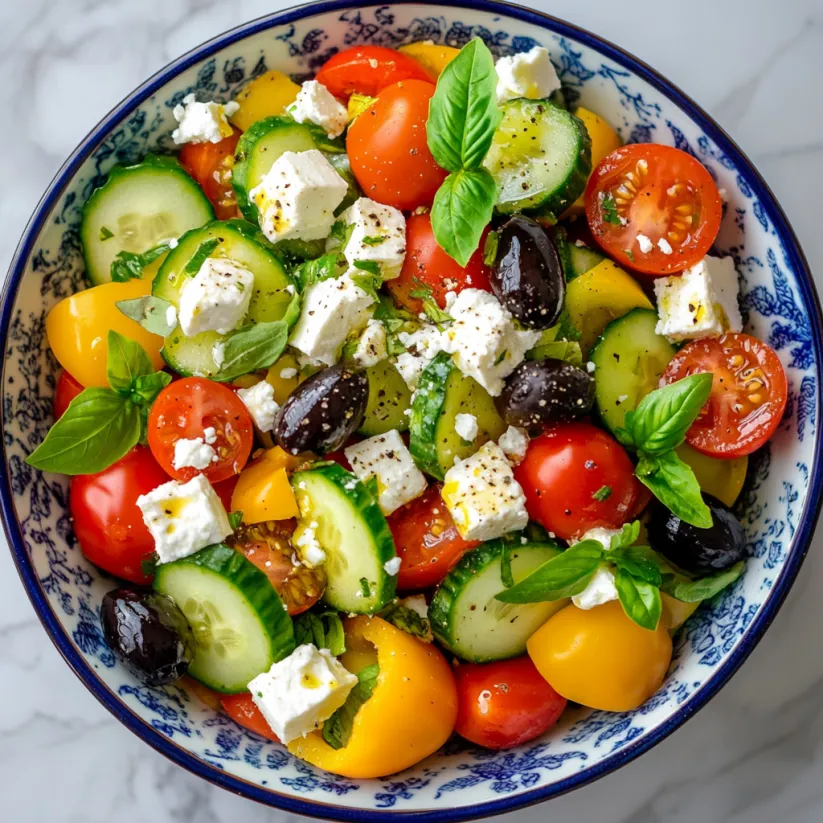 Save Pin
Save Pin
This crisp and colorful Greek salad has become a cornerstone of our family’s summer meals. Each bowl feels like a burst of fresh flavor that instantly brightens our table, and the combination of tangy feta with ripe tomatoes and briny olives always brings us together.
I love how this recipe can be tossed together with what I have at home. The first time I made it, I realized how much better salads taste with the right olive oil and good feta. My children now request it even on cold days because it reminds them of summer.
Ingredients
- Ripe tomatoes: for juicy sweetness and vibrant color. Choose vine-ripened or heirloom varieties for better flavor.
- Cucumbers: for crunch and freshness. English or Persian cucumbers are best since they have fewer seeds and thin skin.
- Red onions: for a pop of sharp flavor. Use mild, fresh onions and slice them thin for a gentle bite.
- Green bell peppers: for an extra layer of crunch. Pick firm and shiny peppers without soft spots.
- Kalamata olives: for that deep Mediterranean briny flavor. Always go for glossy, plump ones from Greece for authenticity.
- Feta cheese: for creamy tang and saltiness. Look for Greek feta made from sheep or goat milk for the closest traditional flavor.
- Extra virgin olive oil: for richness. Select cold-pressed oil and check for a recent harvest date.
- Red wine vinegar: for brightness. Look for a bottle with a balanced tang.
- Dried oregano: for a classic herb finish. Mediterranean oregano has the most intense fragrance.
- Salt: to bring out all the flavors. Choose sea salt or flaky salt for seasoning.
Step-by-Step Instructions
- Prepare the Vegetables:
- Wash tomatoes, cucumbers, and peppers thoroughly under cold running water then dry with a clean towel. Cut tomatoes into generous wedges or chunks about one inch across. Slice cucumbers into half moons a quarter inch thick for ideal crunch and slice onions into very thin rings for a gentle flavor that melds into the salad without overpowering.
- Combine the Base:
- Place the tomato wedges, cucumber slices, bell pepper pieces, and onion rings in a wide shallow bowl. Gently toss with your hands to distribute everything evenly while trying not to bruise the delicate vegetables.
- Layer and Add Olives:
- Scatter the Kalamata olives over the vegetables. Try to space them throughout the salad so every serving gets their unique briny punch. Add whole or halved olives depending on your preference.
- Add the Feta Cheese:
- Break the feta into large chunks instead of fine crumbles and carefully nestle them over the top. This keeps the feta’s texture intact until serving and allows each bite to have a wonderful mix of flavors.
- Whisk the Dressing:
- In a small bowl or a jar with a lid, add three tablespoons of olive oil with one tablespoon of red wine vinegar. Sprinkle in at least one teaspoon of dried oregano and a pinch of salt. Whisk very well or shake in the jar until the dressing looks slightly cloudy and emulsified.
- Dress and Finish:
- Pour the dressing evenly over the salad just before serving. Toss gently with clean hands or two wooden spoons so every ingredient gets a hint of the dressing without getting soggy.
 Save Pin
Save Pin
Feta cheese is my absolute favorite part. Its salty tang reminds me of family trips to the coast where local markets offered the freshest cheese wrapped in brine. My kids always race to see who gets the last chunk from the bowl.
Storage Tips
Refrigerate leftovers promptly in an airtight container. The salad holds its crispness best if dressed just before eating but even after mixing it can stay tasty for up to two days. If making ahead, leave out the feta and dressing until you are ready to serve.
Ingredient Substitutions
If you cannot find Kalamata olives, use any firm black or green olive with a mild flavor. For a dairy free twist, try cubes of creamy avocado instead of feta. Yellow or orange bell peppers add a sweet note if you want to change up the color profile.
Serving Suggestions
This salad is perfect as a stand alone lunch with crusty bread or as a side to roasted chicken or grilled fish. Sometimes I serve it over a bed of baby greens for an even more filling meal. It is also a favorite at picnics because it travels well.
 Save Pin
Save Pin
Cultural and Historical Context
Greek salad reflects the Mediterranean way of eating – simple meals enjoyed with family and friends under the sun. Real Greek salads are always served with pride and without lettuce, allowing each vegetable to shine. This dish comes from centuries of village kitchens where fresh ingredients were the highlight rather than an afterthought.
Commonly Asked Questions
- → What makes feta ideal for this salad?
Authentic Greek feta is crumbly, tangy, and creamy. Made from sheep's or goat’s milk, it offers traditional Mediterranean flavor and bold character that perfectly contrasts with fresh vegetables.
- → Can I substitute olives or cheese?
Kalamata olives provide a signature briny taste, but you may substitute with other black olives if needed. For a dairy-free option, vegan white cheeses work, but the flavor profile will vary somewhat from classic feta.
- → How can I keep vegetables crisp?
Use the freshest produce possible and slice the vegetables just before assembling. Dry them after washing and refrigerate until it’s time to serve for best texture and color.
- → What’s the ideal olive oil for dressing?
Extra virgin olive oil from Greece or the Mediterranean delivers rich, peppery notes and balanced depth, creating a dressing that highlights the salad’s freshness.
- → Are there regional Greek salad variations?
Yes, local additions include capers in Cyclades, green peppers in Thessaly, and purslane in Crete. Every region favors slightly different ingredients and accents, adapting to the Mediterranean’s bounty.
- → What’s a common mistake in preparation?
Using low-quality ingredients or overdressing can overwhelm the salad. Keep cuts uniform and lightly dress just before serving to let the flavors shine.
